


Sri Lankan cuisine has been influenced by many historical, cultural, and other factors. For example, the effects of the Portuguese, Dutch & British colonialists who once ruled Sri Lanka and brought their own cuisines with them; foreign traders such as the Arabic's, Chinese & Malay's who brought new food items; and the cuisine of Southern India have all helped to shape Sri Lankan cuisine. Today, some of the staples of Sri Lankan cuisine are rice, coconut, and spices. The latter are used due to Sri Lanka's history as a spice producer and trading post over several centuries.
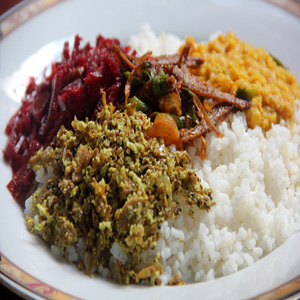 Rice and curry is the main food in Sri Lanka. Sri Lankans consume boiled or steamed rice served with a curry of fish, chicken, beef or mutton along with few vegetable curries, lentil curry, mallum (chopped green leaves and coconut) and crisps called papadam. Dishes are accompanied by pickles, chutneys and sambol; especially coconut sambol, a paste of ground coconut mixed with chillies, maldive fish and lime juice. Sri Lankans use lot of spices such as black pepper, cinnamon, cloves, cardamom, nutmeg and saffron when cooking and for the curries they always use coconut milk.
Rice is first served to the plate and then the accompanied curries are served in much smaller quantities. When consuming you should mix rice with curries and normally consumed using fingers. Most of the Srilankans consume Rice and Curry for lunch.
Rice and curry is the main food in Sri Lanka. Sri Lankans consume boiled or steamed rice served with a curry of fish, chicken, beef or mutton along with few vegetable curries, lentil curry, mallum (chopped green leaves and coconut) and crisps called papadam. Dishes are accompanied by pickles, chutneys and sambol; especially coconut sambol, a paste of ground coconut mixed with chillies, maldive fish and lime juice. Sri Lankans use lot of spices such as black pepper, cinnamon, cloves, cardamom, nutmeg and saffron when cooking and for the curries they always use coconut milk.
Rice is first served to the plate and then the accompanied curries are served in much smaller quantities. When consuming you should mix rice with curries and normally consumed using fingers. Most of the Srilankans consume Rice and Curry for lunch.
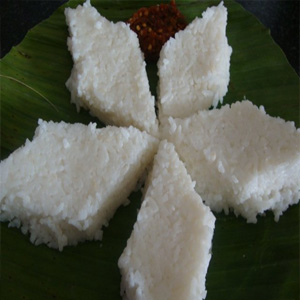 Milk Rice ("Kiribath" in Sinhala) is prepared by cooking rice in thick coconut cream and served with "lunumiris" (prepared by making a paste out of red dried chilli mixed with salt and lime juice). Kiribath is served for breakfast and included in all special occasion menus.
Milk Rice ("Kiribath" in Sinhala) is prepared by cooking rice in thick coconut cream and served with "lunumiris" (prepared by making a paste out of red dried chilli mixed with salt and lime juice). Kiribath is served for breakfast and included in all special occasion menus.
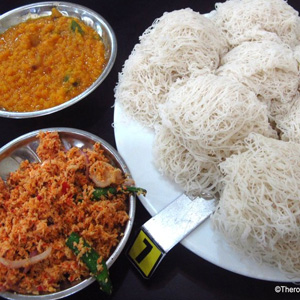 String Hoppers ("Indiappa" in Sinhala) is made out of rice flour. You mix rice flour and hot water to form a dough and pressed out in circlets from a string mold on to wicker mats and then steamed. String hoppers are also consumed with curry and coconut sambol (a paste of ground coconut mixed with chillies, maldive fish and lime juice), and a popular choice for breakfast and dinner.
String Hoppers ("Indiappa" in Sinhala) is made out of rice flour. You mix rice flour and hot water to form a dough and pressed out in circlets from a string mold on to wicker mats and then steamed. String hoppers are also consumed with curry and coconut sambol (a paste of ground coconut mixed with chillies, maldive fish and lime juice), and a popular choice for breakfast and dinner.
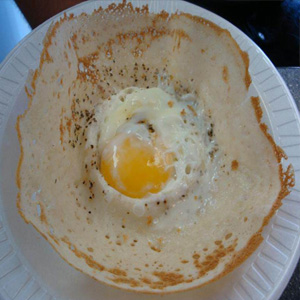 Hoppers ("Appa" in Sinhala) are prepared using a fermented batter, usually made out of rice flour, coconut milk and a little palm toddy or yeast. The batter is normally prepared in the previous night and left to rise overnight and then thinned by adding coconut milk. Hoppers are baked in a round cast-iron pan, to get the soft well-risen center part and the golden brown crisp boarder. To make egg hoppers an egg is added in to the center of the hopper and then bake. Hoppers should be consumed while hot and often accompanied by lunumiris (prepared by making a paste out of red dried chilli mixed with salt and lime juice) and fish or meat curry.
Hoppers ("Appa" in Sinhala) are prepared using a fermented batter, usually made out of rice flour, coconut milk and a little palm toddy or yeast. The batter is normally prepared in the previous night and left to rise overnight and then thinned by adding coconut milk. Hoppers are baked in a round cast-iron pan, to get the soft well-risen center part and the golden brown crisp boarder. To make egg hoppers an egg is added in to the center of the hopper and then bake. Hoppers should be consumed while hot and often accompanied by lunumiris (prepared by making a paste out of red dried chilli mixed with salt and lime juice) and fish or meat curry.
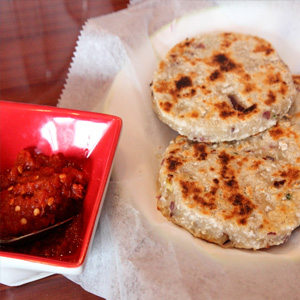 In Sri Lanka most common type of roti is coconut roti ("Pol Roti" in Sinhala) and it is a flat-bread usually made from a dough of wheat flour mixed with shredded coconut. Roti is consumed with lunumiris (prepared by making a paste out of red dried chilli mixed with salt and lime juice) and fish or meat curry.
In Sri Lanka most common type of roti is coconut roti ("Pol Roti" in Sinhala) and it is a flat-bread usually made from a dough of wheat flour mixed with shredded coconut. Roti is consumed with lunumiris (prepared by making a paste out of red dried chilli mixed with salt and lime juice) and fish or meat curry.
 Dosai is an ethnic breakfast food of the Tamil community and also a favorite among many Sri Lankans. A mixture of rice and Urad Dahl ("Ulundu") soaked in water and ground finely to form a dough and the batter is allowed to ferment overnight. Then add water to get the desired thickness and cooked on a greased griddle. Dosai is served hot, either folded in half or rolled like a wrap. It is usually served with chutney and sambar (a thick vegetable broth). Dosai is nutritionally rich and delicious.
Dosai is an ethnic breakfast food of the Tamil community and also a favorite among many Sri Lankans. A mixture of rice and Urad Dahl ("Ulundu") soaked in water and ground finely to form a dough and the batter is allowed to ferment overnight. Then add water to get the desired thickness and cooked on a greased griddle. Dosai is served hot, either folded in half or rolled like a wrap. It is usually served with chutney and sambar (a thick vegetable broth). Dosai is nutritionally rich and delicious.
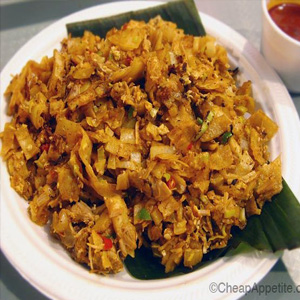 Kottu is a spicy Sri-Lankan stir-fry of shredded "Godamba Roti" (a type of Sri Lankan Roti), vegetables, egg and/or meat, cheese and spices. Kottu is also prepared using shredded string hoppers. Kottu is a popular dinner dish among Sri Lankans.
Kottu is a spicy Sri-Lankan stir-fry of shredded "Godamba Roti" (a type of Sri Lankan Roti), vegetables, egg and/or meat, cheese and spices. Kottu is also prepared using shredded string hoppers. Kottu is a popular dinner dish among Sri Lankans.
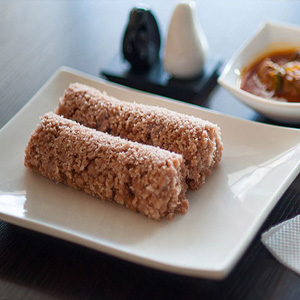 "Pittu" are steamed cylinders of ground rice mixed with grated coconut. Pittu is served with heated coconut milk, lunumiris (prepared by making a paste out of red dried chilli mixed with salt and lime juice) and fish or meat curry.
"Pittu" are steamed cylinders of ground rice mixed with grated coconut. Pittu is served with heated coconut milk, lunumiris (prepared by making a paste out of red dried chilli mixed with salt and lime juice) and fish or meat curry.
Many sweets are served with milk rice ("kiribath") during the Sinhala and Tamil New Year.
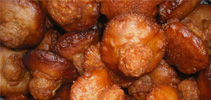 Kevum
Kevum
Oil cake made with a mixure of rice flour and treacle and deep-fried to a golden brown. Types of "kevum" include "Athirasa", Konda Kewum" and "Handi Kavum".
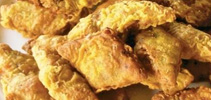 Mung Kevum
Mung Kevum
This is a variation of normal "Kavum" where you add green gram flour ("Mung bean" flour), mixed with treacle and made into a paste. Then cut in to diamond shapes and cover with a rice flour batter and deep fry.
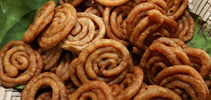 Undu Walalu
Undu Walalu
A sweet popular among Matale and Kandy area, prepared using urad bean flour ("Ulundu) and kithul treacle.
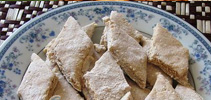 Aluwa
Aluwa
Diamond-shaped rice-flour pastries
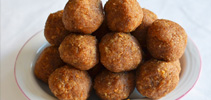 Aggala
Aggala
Rice balls flavored with treacle
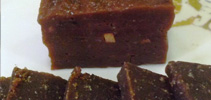 Kalu Dodol
Kalu Dodol
A solid toffee, jelly-like confection made by lengthy reduction of coconut milk thickened with rice flour and sweetened with jaggery.
 Weli Thalapa
Weli Thalapa
A sweet made from rice flour and coconut treacle
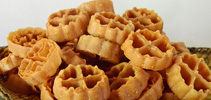 Kokis
Kokis
A savoury crispy biscuit-like food made from rice flour and coconut milk.
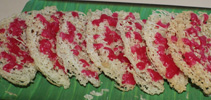 Aasmi
Aasmi
Made with rice flour and the juice of a leaf called "dawul kurundu", (okra juice can be used as a substitute), deep fried and topped with pink-coloured treacle.
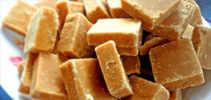 Kiri Toffee
Kiri Toffee
Made with sweetened condensed milk or sugar-thickened pure cow's milk, cardamom and cashews are added for more taste.
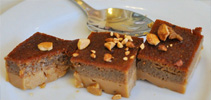 Watalappam
Watalappam
A steamed pudding made with coconut milk, eggs, and jaggery
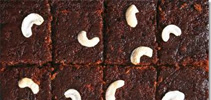 Bibikkan
Bibikkan
A rich, cake-like sweet made from grated coconut, coconut treacle, and wheat flour. It is a specialty of coastal areas.
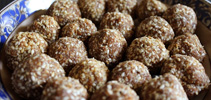 Thala Guli
Thala Guli
Made from ground sesame and jaggery with finely grated coconut.
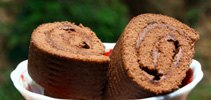 Pushnambu
Pushnambu
A rich, cake-like sweet made from coconut treacle and wheat flour. Cinnamon/cardamom and sweet cumin is often added as a specialty of the Christian population of Sri Lanka.